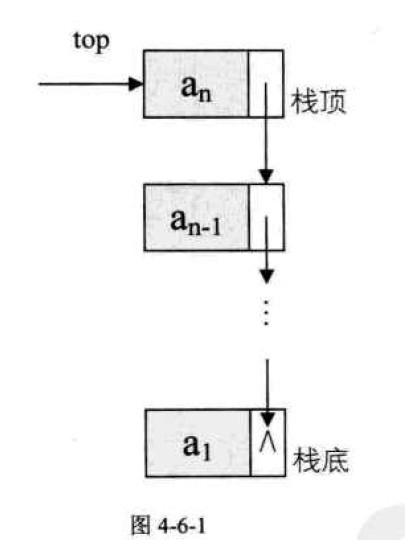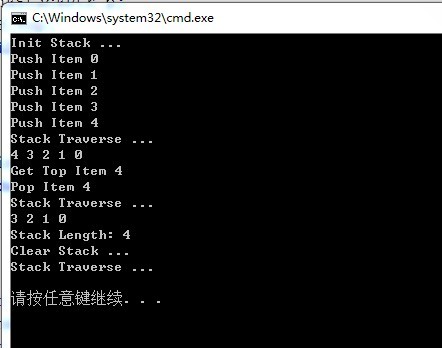当单链表限定只能在头部进行插入和删除操作的时候,即为链栈,一般我们会将单链表的头指针和栈的栈顶指针top合二为一,通常对链栈来说,是不需要头节点的,因为我们维护了栈顶指针。对于链栈来说,基本不存在栈满的情况,除非内存已经没有可以使用的空间,对于空栈来说,链表原定义是头指针指向空,那么链栈的空其实就是top = = NULL的时候。

示例代码:
#include <iostream>
using namespace std;
typedef int ElemType;
typedef struct Node
{
ElemType data;
struct Node *next;
} Node, *NodePtr;
typedef struct LinkStack
{
NodePtr top; //栈顶指针
int count; //元素个数
} LinkStack;
/* 构造一个空栈 */
bool InitStack(LinkStack *ps)
{
cout << "Init Stack ..." << endl;
ps->top = NULL;
ps->count = 0;
return true;
}
/*置为空栈 */
bool ClearStack(LinkStack *ps)
{
cout << "Clear Stack ..." << endl;
if (ps->top == NULL)
return true;
NodePtr p = ps->top;
NodePtr q;
while (p)
{
q = p->next;
free(p);
p = q;
}
ps->top = NULL;
ps->count = 0;
return true;
}
bool StackEmpty(LinkStack LS)
{
return LS.count == 0;
}
int StackLength(LinkStack LS)
{
cout << "Stack Length: ";
return LS.count;
}
/* 返回栈顶元素 */
bool GetTop(LinkStack LS, ElemType *pe)
{
*pe = LS.top->data;
cout << "Get Top Item " << *pe << endl;
return true;
}
/* 压栈 */
bool Push(LinkStack *ps, ElemType Elem)
{
cout << "Push Item " << Elem << endl;
NodePtr s = (NodePtr)malloc(sizeof(Node));
s->data = Elem;
s->next = ps->top;
ps->top = s;
ps->count++;
return true;
}
/* 出栈 */
bool Pop(LinkStack *ps, ElemType *pe)
{
NodePtr p = ps->top;
*pe = p->data;
ps->top = p->next;
free(p);
ps->count--;
cout << "Pop Item " << *pe << endl;
return true;
}
/* 输出栈元素 */
bool StackTraverse(LinkStack LS)
{
cout << "Stack Traverse ..." << endl;
NodePtr p = LS.top;
while (p != NULL)
{
cout << p->data << ' ';
p = p->next;
}
cout << endl;
return true;
}
int main(void)
{
LinkStack LS;
InitStack(&LS);
for (int i = 0; i < 5; i++)
Push(&LS, i);
StackTraverse(LS);
int result;
GetTop(LS, &result);
Pop(&LS, &result);
StackTraverse(LS);
if (!StackEmpty(LS))
cout << StackLength(LS) << endl;
ClearStack(&LS);
StackTraverse(LS);
return 0;
}输出为:

如果栈的使用过程中元素变幻不可预料,有时很小,有时非常大,那么最好使用链栈,反之如果变化在可控范围内,建议使用顺序栈会更好一些。






















 1413
1413

 被折叠的 条评论
为什么被折叠?
被折叠的 条评论
为什么被折叠?








